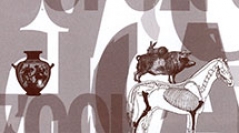

 Anthropozoologica
41 (2) - Pages 57-83
Anthropozoologica
41 (2) - Pages 57-83In the north of Huesca province, in the Sierra de Guara, schematic art is widespread in the region and represents wild animals, mostly deer, alone or in scenes of capture and hunting. Domestic animals are also represented but it is frequently very difficult to identify them. Herds and harnesses suggest the presence of an economy based on animal husbandry, which becomes more and more important, to the detriment of predation practices, but we also suspect that these scenes are more mythical than realist. Levantine art, present in only some rock shelters in Huesca province, is characterized by naturalistic representations of wild animals, deer and wild goats, either isolated or in bands and in scenes of hunting or capture. We propose the hypothesis of a relation between the two iconographic corpuses that is closer than has usually been thought.
Spain, Huesca, River Vero, animals, Levantine, Schematic, Neolithic.